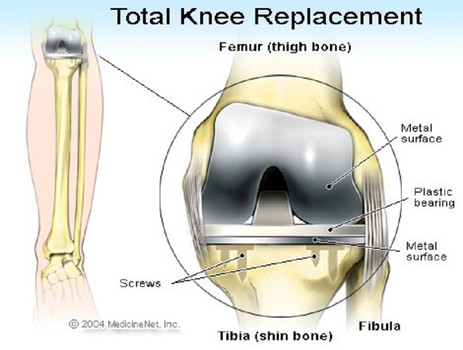Total Knee Arthroplasty is a surgical procedure involving the replacement of diseased or degenerated knee joints with artificial parts. It is a highly normal operation, though it is only suggested to those with significant, crippling pain as a result of severe arthritis, generally caused by osteoarthritis or rheumatoid arthritis. Those who are in need of total knee arthroplasty may have problems walking, climbing stairs and utilizing chairs. Just as with any procedure, there are risks and concerns to be aware of, however it is considered relatively safe. Often, you will experience intense pain relief, along with the ability to use your once stiff and sore knee joints.
The Procedure
During the procedure, a surgeon will cut away the diseased bone and cartilage from your thighbone, kneecap and shinbone. The replacement joint is generally crafted with metal alloys, polymers and high grade plastics. The latest developments in artificial joints have begun to try and replicate the knee’s ability to roll and glide as it moves. After the procedure, there is a roughly 4 to 6 week period before you can resume your usual daily activities, such as shopping, driving and walking. It is best to start off with low-impact activities to allow yourself to become accustomed to the new joint.
Risks and Concerns
Any surgical procedure comes with potential risks, both small and large. There is always the risk of infection, and it is important to know how to tell you have one. The common signs of infection of a replaced joint include a 100 F fever, drainage from the site, an increase in redness, swelling, pain and tenderness, and shaking chills. You are also at risk to develop blood clots in the veins of your legs, or in your lungs. Some have experienced heart attack, stroke and nerve damage as a result as well. There will always be wear and tear on the replacement, at least after some time of using it actively, so it is likely to require a replacement 10-20 years down the line.
Results I Can Expect
A majority of those who decide to undergo total knee arthroplasty experience a high level of pain relief, along with improved mobility of their joints. They are able to return to normal, without pain while they rest and move. These all lead to an improvement in your quality of life, as you will be able to do things yourself once again. You can lead your life, and enjoy yourself! You can enjoy activities like swimming, jogging and hiking, which improves your ability to use the joints, as well as allows you to enjoy the day like you once could.
Follow Up Studies
Many studies have been done as a follow up, to determine the efficacy of total knee arthroplasty, as well as the long term results and benefits. Many focus on the knee’s functionality, as well as the survival rate among the patients participating in the study. For instance, a clinical and radio graphical review of kinematic total knee arthroplasty focused on 36 cases following 13-19 years after the surgery. According to the follow up, 28 out of the 36 reported good or excellent knee function, showing a positive long term outcome in rheumatoid arthritis patients. A retrospective cohort study comprised of 31 patients, 60 years or younger, determined both the survival rate and long term results of total knee arthroplasty for younger patients. They followed a minimum of 10 years, and found the survival rate was at 89.7%. Knee function scores also showed reasonably functioning knee joint replacements
Overall, it can be difficult to decide if you wish to undergo total knee arthroplasty. However, it can be highly beneficial, in particular for those suffering from osteoarthritis and rheumatoid arthritis. If your condition is severe, resulting in intense and crippling pain in the knee joints, you may benefit greatly from the surgical procedure. A majority of studies have shown it to be a safe procedure with useful benefits that improve the quality of life for the patient a thousand fold. While there are some potential complications, such as a dislocation on the replacement joint, for some, the good may outweigh the bad. Be sure to discuss with your health care physician to determine if it is a good match for you. They will be able to let you know if you are applicable.








